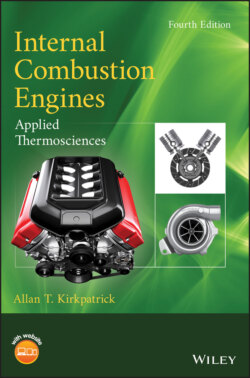Читать книгу Internal Combustion Engines - Allan T. Kirkpatrick - Страница 61
2.8 Finite Energy Release Spark‐Ignition Energy Release
ОглавлениеIn the ideal Otto and Diesel cycles the fuel is assumed to burn at rates that result in constant volume top dead center combustion, or constant pressure combustion, respectively. Actual engine pressure and temperature profile data do not match these simple models, and more realistic modeling, such as a finite energy release model, is required. A finite energy release model is a differential equation model of an engine cycle in which the energy addition is specified as a function of the crank angle. It is also known as a model, since it is a function only of crank angle, and not a function of the combustion chamber geometry.
Energy release models can address questions that the simple gas cycle models cannot. If one wants to know about the effect of spark timing or heat and mass transfer on engine work and efficiency, an energy release model is required. Also, if heat transfer is included, as is done in Chapter 11, then the state changes for the compression and expansion processes are no longer isentropic, and cannot be expressed as simple algebraic equations.
A typical cumulative mass fraction burned, i.e., fraction of fuel energy released, curve for a spark‐ignition engine is shown in Figure 2.15. The figure plots the cumulative mass fraction burned versus the crank angle. The characteristic features of the mass fraction burned curve are an initial small slope region beginning with spark ignition and the start of energy release at , followed by a region of rapid growth, and then a more gradual decay. The three regions correspond to the initial ignition development, a rapid burning region, and a burning completion region. This S‐shaped curve can be represented analytically by a trigonometric function, as indicated by Equation (2.69):
(2.69)
or an exponential relation, known as a Wiebe function, as given in Equation (2.70):
(2.70)
where
The Wiebe function is named after Ivan Wiebe (1902–1969), a Russian engineer who developed a energy release model based on analysis of combustion chain reaction events (Ghojel 2010). The Wiebe function can be used for modeling the energy release in a wide variety of combustion systems. For example, as shown in the next section, diesel engine combustion, which has a premixed phase and a diffusion phase, can be modeled using a combined double Wiebe function. The energy release curve for the diesel engine is double peaked due to the two combustion phases.
Figure 2.15 Cumulative mass fraction burned function.
Since the cumulative energy release curve asymptotically approaches a value of 1, the end of combustion needs to defined by an arbitrary limit, such as 90%, 99%, or 99.9% complete combustion; i.e., 0.90, 0.99, or 0.999, respectively. Corresponding values of the Wiebe efficiency factor are 2.302, 4.605, and 6.908 respectively. The value of the efficiency factor was used by Wiebe in his engine modeling calculations.
The values of the form factor and burn duration depend on the particular type of engine, and on some degree on the engine load and speed. These parameters can be deduced using experimental burn rate data, which in turn is obtained from the cylinder pressure profile as a function of crank angle, discussed in more detail in the combustion analysis section of Chapter 12. Values of and have been reported to fit well with experimental data (Heywood 1988). For further general information about energy release models the reader is referred to Foster (1985).
The rate of energy release for the Wiebe function as a function of crank angle, Equation (2.71), is obtained by differentiation of the cumulative energy release function:
(2.71)
The computer program BurnFraction.m is listed in Appendix F and can be used to plot the Wiebe function cumulative burn fraction and the rate of energy release for different engine conditions. The use of the program is detailed in the following example.
